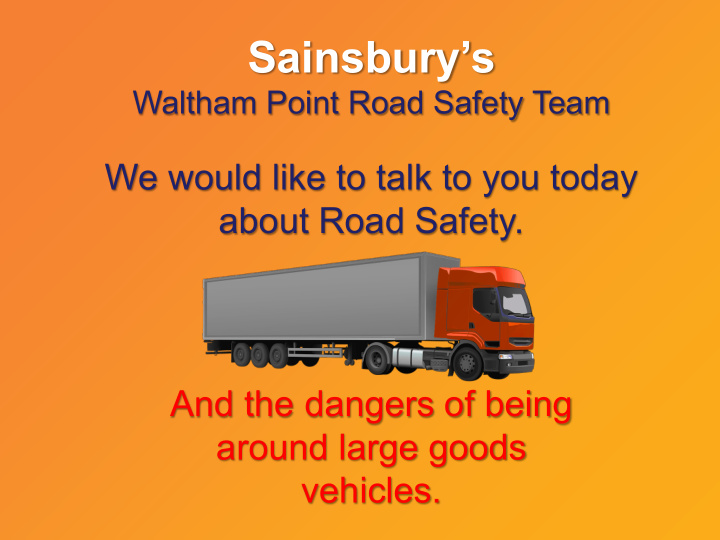



Sainsbury’s Waltham Point Road Safety Team We would like to talk to you today about Road Safety. And the dangers of being around large goods vehicles.
19
32
Waltham Point’s fleet of vehicles cover around 8.3 million kilometres per year delivering to our stores, which is roughly the same as driving 206 times around the world or 23 times to the moon.
Or you could walk around the outside of our depot which is 1.6 km. However, this would take you roughly 196 years to complete the 8.3 million kilometres.
Cycle Safety Cyclists & Lorries should be able to use the same roads as each other. However, both MUST understand each other’s needs.
All new lorries now come with 6 mirrors But please remember, like you the driver only has one pair of eyes and can only look in one mirror at a time.
Does anybody know what we call the areas around a vehicle where you can’t be seen? Blind Spots All vehicles have blind spots
Blind Spots
From the moment the driver gets behind the wheel in a normal steering position, he can NOT see any of the red carpet!
Undertaking at Junctions can be fatal • As the lorry starts to make it’s turn so the blind spot area changes. • That is12 Cyclists in the drivers blind spot!
Our new rigid vehicles come with 4 cameras, 1 on each side, 1 at the front and 1 at the rear. These give the driver a 360 degree view around the vehicle, which is displayed on a small screen mounted in the cab. But remember the driver still only has one pair of eyes
Some stickers that you may see on a Sainsbury’s vehicle.
Cycle Safety Tips • Riding a cycle that is too big, too small or badly adjusted for you can affect your balance. • Make sure your cycle is safe to ride. • Always wear a cycle helmet – it will help to protect you if you have an accident . • At night or in poor visibility always use your lights and wear something bright or luminous.
Pedestrian Safety • The blind spots around vehicles apply to pedestrians the same as cyclists. REMEMBER • How do you know if a vehicle is about to reverse? • What colour are the reversing lights? WHITE
Crossing the Road The Green Cross Code. • A - First find a safe place to cross. • B - Stop just before you get to the kerb. • C - Look all around for traffic and listen. • D - If traffic is coming, let it pass . • E - When it is safe, go straight across the road – do not run.
• When out walking at night always wear something bright or luminous • When crossing the road always use a marked crossing whenever possible. When using any type of crossing you should: • Always check that the traffic has stopped before you start to cross. • Always cross between the studs or over the zebra markings. Do not cross at the side of the crossing or on the zig-zag lines, as it can be dangerous. Try and cross to the side of the crossing furthest from the traffic. • Before crossing try and make eye contact with the driver(s). Zebra crossings have flashing beacons
When using signal controlled crossings (Traffic Lights. Pelican or Puffin) you should: • only start to cross the road when the green figure shows. If you have started to cross the road and the green figure goes out, you should still have time to reach the other side, but do not delay. If no pedestrian signals have been provided, watch carefully and do not cross until the traffic lights are red and the traffic has stopped. • keep looking and check for traffic that may be turning the corner. • remember that traffic lights may let traffic move in some lanes while traffic in other lanes has stopped. At traffic lights, puffin and pelican crossings. *At pelican crossings only.
One vehicle you are more likely to see outside your home or on the way to school are the Sainsbury’s and other home delivery vans. These are smaller in size and weight but still have blind spots and have less mirrors, so be extra careful around them.
So why is road safety important ? • Around 5,000 children under the age of 16 die or are seriously injured on Britain’s roads each year. • Nearly two in three road accidents happen when children are walking or playing. • Most serious road accidents involving children walking and cycling happen close to home. • Almost two-thirds of child accident victims are boys. • As a child gets older the risk of a road accident increases.
One final thing If you are ever in a broken down car at the side of a road or motorway then you always need to get out of the car and wait in a safe place behind the car and behind the barrier if there is one.
SO PLEASE REMEMBER! BE AWARE! BE SAFE!!
Recommend
More recommend